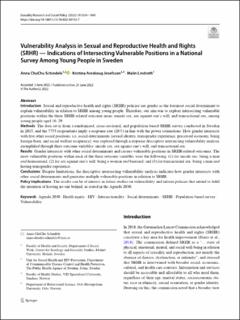| dc.contributor.author | Schindele, Anna ChuChu | |
| dc.contributor.author | Areskoug Josefsson, Kristina | |
| dc.contributor.author | Lindroth, Malin | |
| dc.date.accessioned | 2023-02-03T13:44:16Z | |
| dc.date.available | 2023-02-03T13:44:16Z | |
| dc.date.created | 2022-09-22T13:11:42Z | |
| dc.date.issued | 2022 | |
| dc.identifier.citation | Sexuality Research & Social Policy. 2022, 19, 1034-1045. | en_US |
| dc.identifier.issn | 1868-9884 | |
| dc.identifier.uri | https://hdl.handle.net/11250/3048357 | |
| dc.description.abstract | Introduction: Sexual and reproductive health and rights (SRHR) policies use gender as the foremost social determinant to explain vulnerability in relation to SRHR among young people. Therefore, our aim was to explore intersecting vulnerable positions within the three SRHR-related outcome areas: unsafe sex, sex against one’s will, and transactional sex, among young people aged 16–29.
Methods: The data set is from a randomised, cross-sectional, and population-based SRHR survey conducted in Sweden in 2015, and the 7755 respondents imply a response rate (26%) in line with the power estimations. How gender intersects with fve other social positions, i.e. social determinants (sexual identity, transgender experience, perceived economy, being foreign-born, and social welfare recipiency), was explored through a stepwise descriptive intersecting vulnerability analysis exemplifed through three outcome variables: unsafe sex, sex against one’s will, and transactional sex.
Results: Gender intersects with other social determinants and creates vulnerable positions in SRHR-related outcomes. The most vulnerable positions within each of the three outcome variables were the following: (1) for unsafe sex: being a man and homosexual; (2) for sex against one’s will: being a woman and bisexual; and (3) for transactional sex: being a man and having transgender experience.
Conclusions: Despite limitations, the descriptive intersecting vulnerability analysis indicates how gender intersects with other social determinants and generates multiple vulnerable positions in relation to SRHR.
Policy Implications: The results can be of interest in future studies on vulnerability and inform policies that intend to fulfl the intention of leaving no one behind, as stated in the Agenda 2030. | en_US |
| dc.language.iso | eng | en_US |
| dc.publisher | Springer | en_US |
| dc.rights | Navngivelse 4.0 Internasjonal | * |
| dc.rights.uri | http://creativecommons.org/licenses/by/4.0/deed.no | * |
| dc.subject | vulnerability | en_US |
| dc.subject | population-based survey | en_US |
| dc.subject | SRHR | en_US |
| dc.subject | social determinants | en_US |
| dc.subject | intersectionality | en_US |
| dc.subject | HIV | en_US |
| dc.subject | health equity | en_US |
| dc.subject | Agenda 2030 | en_US |
| dc.title | Vulnerability analysis in sexual and reproductive health and rights (SRHR) — Indications of intersecting vulnerable positions in a nnational survey among young people in Sweden | en_US |
| dc.type | Peer reviewed | en_US |
| dc.type | Journal article | en_US |
| dc.description.version | publishedVersion | en_US |
| dc.rights.holder | © The Author(s) 2022 | en_US |
| dc.source.pagenumber | 1034-1045 | en_US |
| dc.source.volume | 19 | en_US |
| dc.source.journal | Sexuality Research & Social Policy | en_US |
| dc.identifier.doi | 10.1007/s13178-022-00742-7 | |
| dc.identifier.cristin | 2054338 | |
| cristin.ispublished | true | |
| cristin.fulltext | original | |
| cristin.qualitycode | 1 | |

